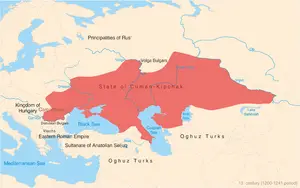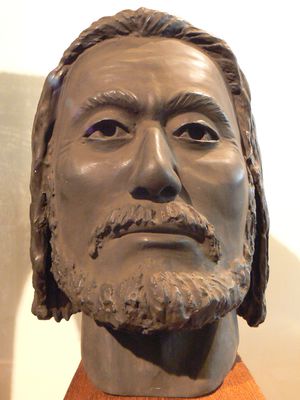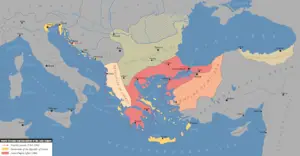Difference between revisions of "How Did the Cumans Influence the Fourth Crusade"
m (Admin moved page How Did the Cumans Influence the Fourth Crusade? to How Did the Cumans Influence the Fourth Crusade) |
|
(No difference)
| |
Latest revision as of 21:25, 28 September 2021
The Fourth Crusade (1202-1204) was unlike any crusade before or after it because instead of pitting Christian crusaders against Muslim armies, it was a war between the forces of Western Christianity and Orthodox Christianity. Although the Roman Catholic Church and the Greek Orthodox Church officially split in 1054, they maintained somewhat cordial relations: Pope Urban II (in power 1088-1099) even called for the First Crusade (1095-1099) partly at the behest of the Byzantine Emperor Alexius I Comnenos (ruled 1081-1118), whose lands were being encroached on by the Muslim Seljuk Turks. But as the Crusades continued, Westerners began turning their eyes toward the Byzantine Empire.
The Germans, Franks, Normans, and other Western crusaders saw how wealthy the Byzantine Empire was and began coveting some of that wealth for themselves. The Republic of Venice was particularly interested in Byzantium’s wealth, as it was a merchant/trade based state with many Venetians already living in the Byzantine capital of Constantinople. The Catholic Pope of the time, Innocent III (in power 1198-1216) also saw potential in the Byzantine Empire. Although Innocent recognized Byzantium as a legitimate Christian kingdom and initially threatened any Western crusaders with ex-communication if they attacked Orthodox Christians, he hoped that at least peripheral lands in the Byzantine Empire could be peeled off for the Roman Church. Once the Western crusaders entered Byzantine territory, though, things immediately became very complicated.
The crusaders were actually invited to Constantinople by the short-lived Emperor Alexius IV (reigned 1203-1204) before he was killed by his successor, Alexius IV (ruled 1204). The death led to the Western coalition declaring war on Alexius IV, taking Constantinople, and installing their own “Latin” dynasty that lasted until 1216. As this all was taking place, Kaloyan (reigned 1170-1207), the Tsar of Bulgaria, embarked on his own campaign to conquer the Byzantine Empire. Among the backbone of Kaloyan’s army were the nomadic steppe people, the Cumans.
The Cumans had an immediate impact on the course of the Fourth Crusade. They were highly effective on the battlefield against the Western crusaders, helping Kaloyan conquer much of the Balkans. As the war endured, though, Kaloyan became cruel and used the Cumans as a cudgel against the Greeks and other people of the Balkans. The wanton destruction of the Cumans eventually pushed the Greeks to the side of the Western crusaders and when there was little left for the Cumans to loot, they simply returned to their lands north of the Danube River. In the end, the Cumans were much more harmful to Kalyon’s efforts than they were beneficial.
The Cumans
The Cumans were originally a nomadic steppe people of Turkic ethnic origins, but unlike most of the other Turkic groups the Cumans were known for having fair skin, blue eyes, and lighter colored hair. Although they were not literate as a group at the time of the Fourth Crusade, many of their neighbors wrote about their deeds. The term “Cuman” is actually what the medieval Western scholars called them in the Latin language, while the Russians knew them as Polovtsians. The Cumans were also sometimes referred to as Kipchaks in the Far Eastern sources, although the Kipchaks were technically a different group. [1]
The Cumans joined the Kipchak federation in the early eleventh century and became the vanguard of the western arm of the federation. [2] The extent of the Cuman Empire, known as Cumania, stretched from the Irtysh River in Siberia in the east to the Danube River in the west. The northern boundaries were not well defined, but the southern boundary was a roughly latitudinal line that went from the Black Sea, the Caucus Mountains, and Lake Balkhash.
Some of the Cumans’ earliest battles with Europeans were when their hordes began entering the territory of the Rus’ states such as Kiev in the tenth century. [3] Despite the problems that the Cumans gave the Rus’, or possibly because of them, other Europeans sought the assistance of the Cumans.
Six hordes of Cumans aligned with the Magyars entered Hungary in the ninth century and although they became fairly assimilated into the Hungarian population, other Cumans continued to raid Hungary into the eleventh century. [4] As the Fourth Crusade began, Andrew II (ruled 1205-1235), the King of Hungary, settled Teutonic knights in Carpathia to defend his kingdom against Cuman raids. [5] The Cumans may have worn out their welcome with the Hungarians/Magyars, but different Rus’ princes and certain Byzantine emperors used them as mercenaries at times. But nowhere in Eastern Europe were the Cumans employed as much as in Bulgaria during the Fourth Crusade.
Kaloyan and the Cumans
The Cumans truly influenced many of the Eastern European kingdoms of the Middle Ages, but none more than Bulgaria. The Kingdom of Bulgaria had a number of different sources of influences, beginning with the Turkic Bulgars and by the Middle Ages they had become Christianized and heavily influenced by the Slavs. When a new Bulgarian dynasty came to power under Asen (reigned 1186-1196), the Bulgarians reaffirmed their ties to the world of the steppe. Asen is actually a Turkic name and when he and his brother Peter were originally defeated by the Byzantines in their initial independence bid, they fled north of the Danube River to the Cumans. [6] Asen then establish a new dynasty by bringing the Cumans, Bulgars, and Vlakhs into an alliance. [7] The new Bulgarian kingdom gained independence from Byzantium, but Kaloyan wanted to rule the entire region.
Kaloyan, known in the Western sources as “Johanitza,” was a very ambitious and sometimes brutal man, although no more so than other rulers of the period. He claimed the title tsarand wanted to be recognized as emperor, so he entered into negotiations with Pope Innocent III. [8] Although Innocent wanted to win Bulgaria over to the Roman Church, Kaloyan was asking for too much. There was already a German dynasty that claimed to be the true emperors of Rome as well as the Byzantine emperor of course. Kaloyan learned he could not rely on the pope as an ally, but a drastic change in dynastic politics made him and the Cumans major players in early thirteenth century Eastern European geopolitics.
The Germans, who were the rulers of the Holy Roman Empire, as well as the English, Franks, Normans, and Italians all wanted more influence in southeastern Europe, and if possible, to rule Byzantium. The opportunity came when the Byzantine Emperor Alexius IV was usurped and fled to Philip of Swabia. A new crusade was organized to presumably reinstall Alexius IV’s rule of Byzantium. After the crusaders took Constantinople and established their own dynasty, many of the Greeks saw Kaloyan as a potential savior. He was, after all, an Orthodox Christian and familiar with the Greek people. The thirteenth century Western chroniclers, Joinville and Villehardouin, wrote about the situation.
“So they secretly chose envoys from all the cities in the empire and sent them to King Johanitza, regardless of the fact that he had long been their enemy and was still at war with them. These envoys told Johanitza that the Greeks proposed to make him Emperor; they would place themselves entirely in his hands, and kill all the French and Venetians in the empire.” [9]
The Cumans and the Crusaders
Kaloyan wasted no time embarking on his campaign against the crusaders. At the vanguard of his army were the Cumans, whom he used to help relieve the crusader siege of Adrianople in 1205. The Greeks of Adrianople were desperate, as they had been besieged for over a month, when Kaloyan and the Cumans arrived and engaged the crusaders in battle from April 12-14, 1205. The crusaders initially had the upper hand with the advantage of their heavy arms and armor in close-quarters combat, but the Cumans eventually won the battle when they did their famous feigned retreat.
“The Comte Louis came out first with his battalion. He sent back a message to the Emperor urging him to follow and immediately started off in pursuit of the Comans. Alas! how little our army kept to the course of action agreed on the night before! Instead of remaining by the camp, our men pursued the Comans for nearly two leagues, attacking them at close quarters and keeping up the chase for a very long time. At length the Comans turned round and charged them, uttering piercing yells as they let their arrows fly.” [10]
The crusaders were obviously unfamiliar with the Cumans steppe tactics, and they were also unaware of their brutality. After the crusaders returned to Constantinople, Kaloyan rewarded the Cumans for their service by allowing them to pillage Thrace for two months. Once the Cumans had raped and pillaged everything in their path, they returned home north of the Danube. [11]
The Cumans returned to the Balkans less than a year later when they, along with their Vlakh and Greek allies, engaged a large crusader force at Rousion on February 1, 1206. Once again, the Cumans used their mobility to their advantage by attacking the rear of an advancing crusader column. The crusaders lost yet again, but even more important, the Cumans went on another prolonged spree of violence.
“Before long the Comans and Wallachians had overrun the land as far as the gates of Constantinople, where the regent, with as many men as he had at his command, was then residing. He was feeling very sad and extremely worried at not being able to get enough men to defend his land. Because of this the Comans were seizing all the cattle in the countryside, carrying off men, women, and children wherever they found them, destroying castles and cities as they passed, everywhere causing such ruin and desolation that no one has ever heard tell of anything to surpass it.” [12]
The Cumans then returned to Cumania and did not again take part in the Fourth Crusade. The Greeks of Adrianople actually went over to the crusaders due to the Cumans’ brutality, forcing Kaloyan to give up his own crusade and returned to Bulgaria. [13] The Cumans, though, would have one last bit of impact on the Fourth Crusade. Not long after he returned to Bulgaria, Kaloyan was murdered, probably by his Cuman bodyguards. [14]
Conclusion
The enigmatic steppe people known in the West as the Cumans had a major impact on the Fourth Crusade. As the Western Roman Catholics fought the Greek Orthodox Christians for control of Constantinople, the Cumans were the “wildcard” of the Bulgarian Tsar Kaloyan.
Although the Cumans defeated the crusaders in two major battles, they ended up doing Kaloyan’s cause more harm than good. Their brutality eventually pushed the Greeks of the Balkans over to the crusaders and even worse, Cumans assassinated Kaloyan, ending any chance he had to conquer Constantinople. In the end, the Byzantines drove the crusaders out of Constantinople in 1216, although the re-established Byzantine Empire was a shadow of its former self.
References
- ↑ Golden, Peter B. “Religion among the Qipčaqs of Medieval Eurasia.” Central Asiatic Journal 42 (1998) p. 186
- ↑ Klyashtornyj, Sergej G. “The Polovican Problem (II): Qipčaqs, Comans, and Polovcians.” Acta Orientalia Academia Scientiarium Hungaricae 58 (2005) p. 47
- ↑ Font, Márta. “Old-Russian Principalities and Their Nomadic Neighbours: Stereotypes of Chronicles and Diplomatic Practice of the Princes.” Acta Orientalia Academia Scientiarium Hungaricae 58 (2005) p. 269
- ↑ MacArtney, C. A. “The Eastern Auxiliaries of the Magyars.” Journal of the Royal Asiatic Society of Great Britain and Ireland 1 (1969) pgs. 51-55
- ↑ Vásáry, István. Cumans and Tatars: Oriental Military in the Pre-Ottoman Balkans, 1185-1365. (Cambridge: Cambridge University Press, 2009), p. 32
- ↑ Vásáry, p. 17
- ↑ Vásáry, 41
- ↑ Morris, Rosemary. “Northern Europe Invades the Mediterranean, 900-1200.” In The Oxford History of Medieval Europe. Edited by George Holmes. (Oxford: Oxford University Press, 2001), p. 221
- ↑ Joinville, Jean de, and Geoffroy de Villehardouin. Chronicles of the Crusades. Translated by M. R. B. Shaw. (London: Penguin, 1963), XV, p. 115
- ↑ Joinville and Villehardouin, XVI, p. 121
- ↑ Vásáry, p. 265
- ↑ Joinville and Villehardouin, XVIII, p. 137
- ↑ Joinville and Villehardouin, XX, p. 153
- ↑ Vásáry, p. 53



